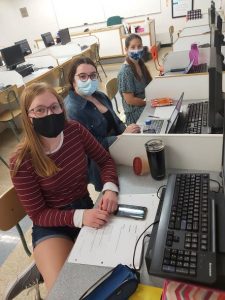I hate to bring up the “C” word, but if there was one thing that the Covid-19 pandemic did, was expand and in many cases introduce the use of blended learning into many of our classrooms. This includes my own. Uh.. check that.. many of us had been doing this for many years, in different capacities to make our classrooms more inclusive, user friendly and technologically integrated. But, with that being said, we may not have called it a “Blended Model” until either the pandemic started, or carried on for years to come and massive levels of absenteeism developed not just in our Saskatchewan, but national and global classroom settings and teachers sought solutions.
 – Students in my classroom during the pandemic
– Students in my classroom during the pandemic
Throughout my career there has been a variety of digital identities and platforms presented and even force fed to teachers: a portal, FlipGrid, Padlet, Google Classroom, Teams, etc etc. For me, the solution has been Google Classroom. It has its kinks and failings, but it definitely to me and my students has been the most universally user friendly. The struggles: a technological learning curve, organization, and engagement. As much as we say that students are masters of technology, not all of them are. They are selective masters. I still get asked on a daily basis how to submit assignments online, even though I have reviewed the process several times throughout the school year. Students are very overwhelmed with multiple platforms being offered by multiple teachers and then add their own interests. Organization is a struggle for many students, especially that key group that are some version of a hybrid modern Luddite. The question of, where do I find this or can I just get it on paper for the fifth time? is another frequent flyer. This is a select group, but what is not so selective is the everlasting challenge of engagement. How do we make a blended model interesting and engaging when we are not standing in front of them demanding their attention or when their world is so wildly overstimulated already? These are key questions to consider and work through in order to further develop the use of a blended model within my own classroom.
My own classroom has changed and developed over the years, much like myself as a teacher. I have been fortunate to always be teaching my favourite subject: History. I have also taught ELA and Social Studies, Law, and Psychology and I can’t forget about those oddball fill in classes like Grade 7 Art here and there. I was so eager to learn about online learning that I took one year to strictly teach History 10 and History 30 to online learners through Moodle on behalf of my school division. I was developing the courses online from scratch. I was really set with an impossible task, develop it, teach it, assess it, learn how to build with the platform and also teach in-person simultaneously. It only lasted the one year. However, I have continued to keep this in the back of my head to see how I can use this previous knowledge to help my students in the future.
Blended learning has become a key component of today’s classroom, in my experience. This is because we are still healing and rallying to seek a sense of normalcy in our lives and in our education in a post Covid world. In the past, students who had the sniffles would always be at school, much like the teacher who also had the sniffles. Today, this has become more taboo, in a good way. People are staying at home when they are sick, however, we are also seeing other side effects, absenteeism is at record highs, for numerous reasons. Health on many different levels, physical, mental or spiritual is on the decline. The result, a greater need for teachers to be doing our utmost to present a variety of learning opportunities to our students and not sticking to a strictly traditional model of teaching and learning for our students.
Yes! I totally agree with your points here. Absenteeism on the rise has also increased the need for accountability for teachers, students, parents, etc. and sometimes we aren’t met with the accountability required despite us as the teachers spending endless hours making content available. I really like your point about student organization; students now, instead of keeping a binder organized, have to keep a running tally of what educational platforms/apps to check for different classes, which I totally understand could be overwhelming. Thank you for sharing!
So true about accountability and the hours we spend working to make content available for students! It is overwhelming for us as teachers and for students. There has been times when I have felt overwhelmed and my principal has looked at me and just said, “mark less.” And then I feel like I am having this crisis as a teacher, because it is so true, but we feel we need to be doing so much for that accountability part! Anyway, I appreciate your response!